Hyatt Hotel Industry: STEEP, Porter's Five Forces, and SWOT Analysis
VerifiedAdded on 2023/03/17
|9
|1573
|28
Case Study
AI Summary
This report provides a comprehensive analysis of the Hyatt hotel industry, examining both its internal and external business factors. The analysis begins with an executive summary, followed by an introduction that highlights the importance of understanding these factors in a competitive market. The report then delves into the macro environment using STEEP analysis (Social, Technological, Economic, Environmental, and Political factors) to assess external influences on Hyatt. The micro environment is evaluated using Porter's Five Forces to understand the competitive landscape. A SWOT analysis is conducted to identify Hyatt's strengths, weaknesses, opportunities, and threats. The report recommends the introduction of a new budget sub-brand to cater to the middle-class customer segment. The report concludes by summarizing the key findings and recommendations, emphasizing the impact of external factors, intense competition, and the need for strategic adjustments. This analysis is supported by references to relevant academic and industry sources.
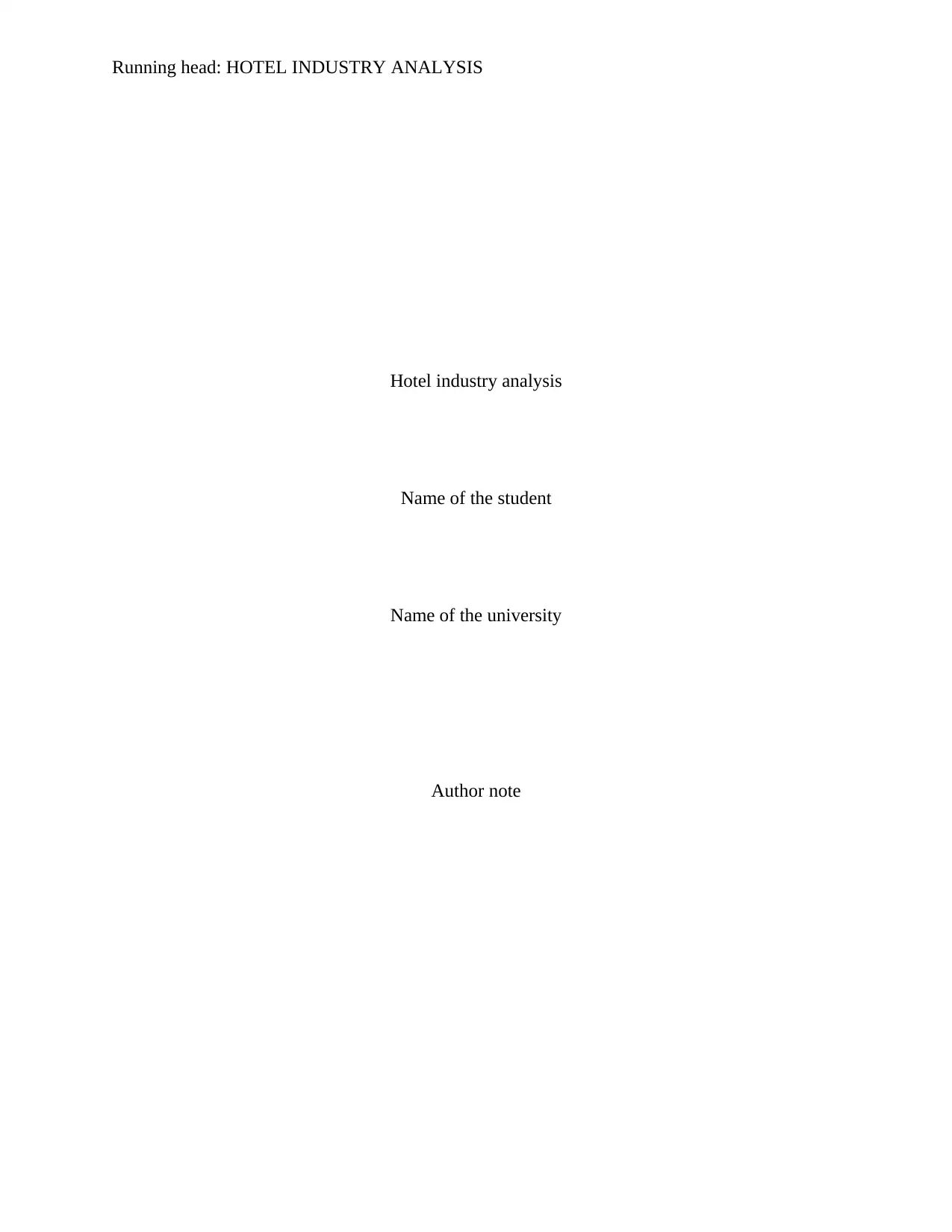
Running head: HOTEL INDUSTRY ANALYSIS
Hotel industry analysis
Name of the student
Name of the university
Author note
Hotel industry analysis
Name of the student
Name of the university
Author note
Paraphrase This Document
Need a fresh take? Get an instant paraphrase of this document with our AI Paraphraser
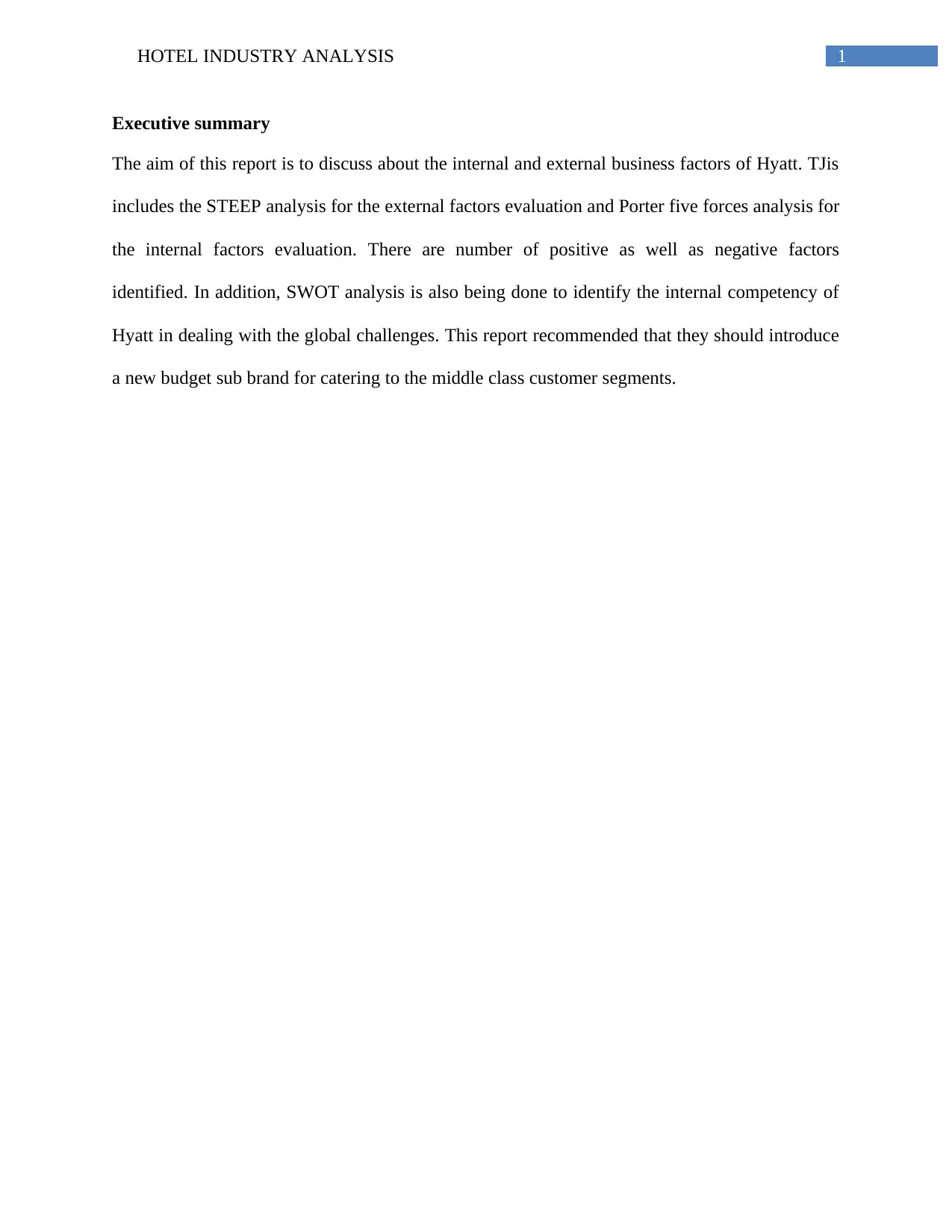
1HOTEL INDUSTRY ANALYSIS
Executive summary
The aim of this report is to discuss about the internal and external business factors of Hyatt. TJis
includes the STEEP analysis for the external factors evaluation and Porter five forces analysis for
the internal factors evaluation. There are number of positive as well as negative factors
identified. In addition, SWOT analysis is also being done to identify the internal competency of
Hyatt in dealing with the global challenges. This report recommended that they should introduce
a new budget sub brand for catering to the middle class customer segments.
Executive summary
The aim of this report is to discuss about the internal and external business factors of Hyatt. TJis
includes the STEEP analysis for the external factors evaluation and Porter five forces analysis for
the internal factors evaluation. There are number of positive as well as negative factors
identified. In addition, SWOT analysis is also being done to identify the internal competency of
Hyatt in dealing with the global challenges. This report recommended that they should introduce
a new budget sub brand for catering to the middle class customer segments.
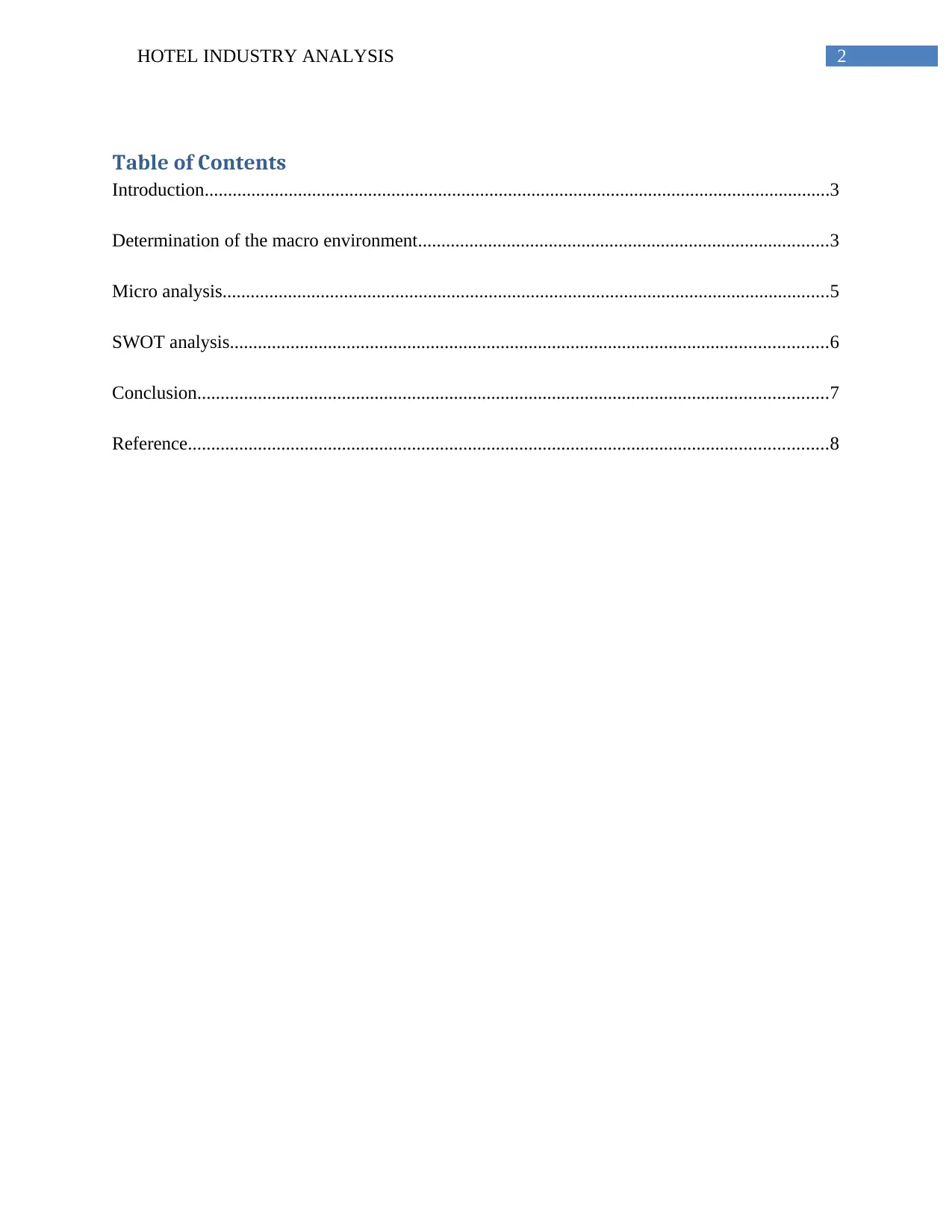
2HOTEL INDUSTRY ANALYSIS
Table of Contents
Introduction......................................................................................................................................3
Determination of the macro environment........................................................................................3
Micro analysis..................................................................................................................................5
SWOT analysis................................................................................................................................6
Conclusion.......................................................................................................................................7
Reference.........................................................................................................................................8
Table of Contents
Introduction......................................................................................................................................3
Determination of the macro environment........................................................................................3
Micro analysis..................................................................................................................................5
SWOT analysis................................................................................................................................6
Conclusion.......................................................................................................................................7
Reference.........................................................................................................................................8
⊘ This is a preview!⊘
Do you want full access?
Subscribe today to unlock all pages.

Trusted by 1+ million students worldwide
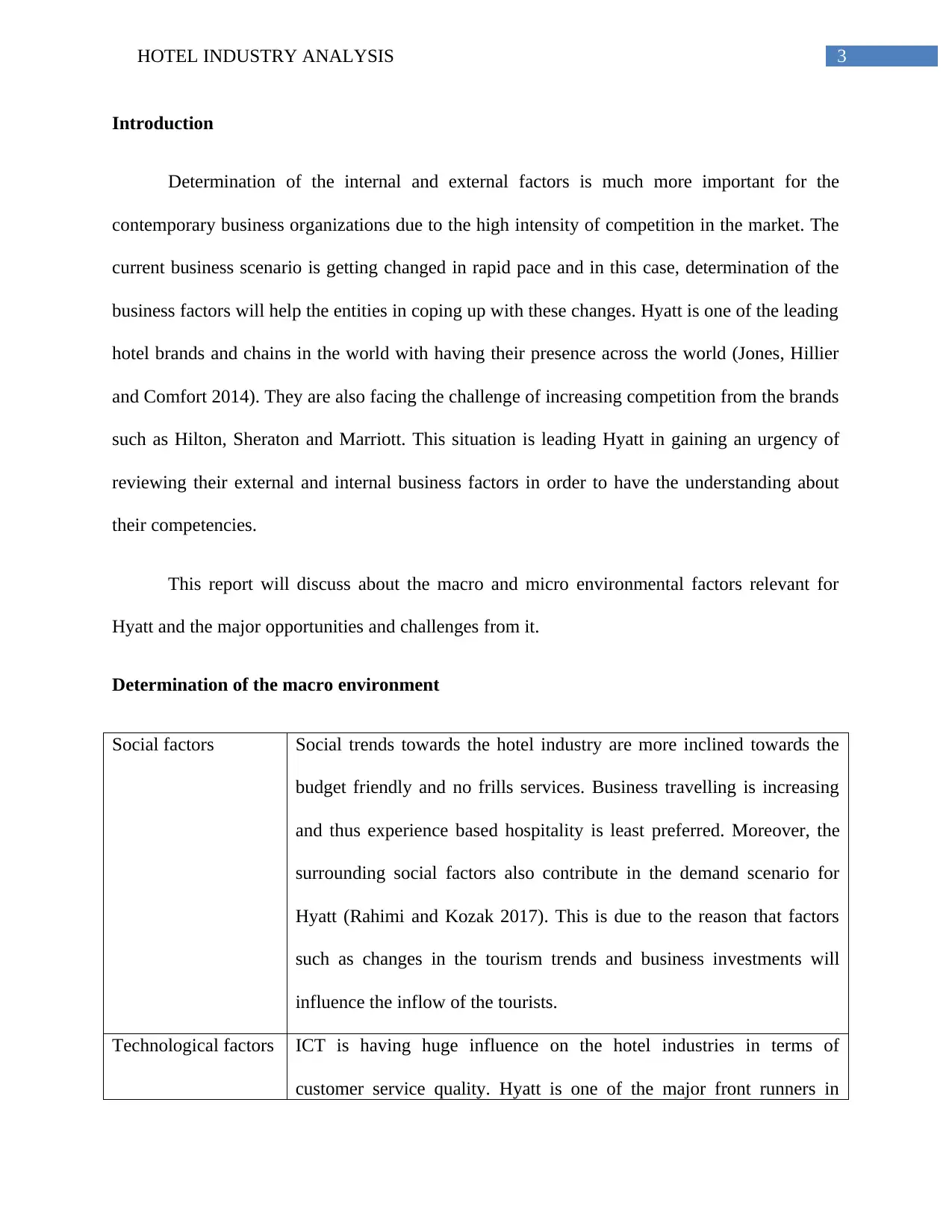
3HOTEL INDUSTRY ANALYSIS
Introduction
Determination of the internal and external factors is much more important for the
contemporary business organizations due to the high intensity of competition in the market. The
current business scenario is getting changed in rapid pace and in this case, determination of the
business factors will help the entities in coping up with these changes. Hyatt is one of the leading
hotel brands and chains in the world with having their presence across the world (Jones, Hillier
and Comfort 2014). They are also facing the challenge of increasing competition from the brands
such as Hilton, Sheraton and Marriott. This situation is leading Hyatt in gaining an urgency of
reviewing their external and internal business factors in order to have the understanding about
their competencies.
This report will discuss about the macro and micro environmental factors relevant for
Hyatt and the major opportunities and challenges from it.
Determination of the macro environment
Social factors Social trends towards the hotel industry are more inclined towards the
budget friendly and no frills services. Business travelling is increasing
and thus experience based hospitality is least preferred. Moreover, the
surrounding social factors also contribute in the demand scenario for
Hyatt (Rahimi and Kozak 2017). This is due to the reason that factors
such as changes in the tourism trends and business investments will
influence the inflow of the tourists.
Technological factors ICT is having huge influence on the hotel industries in terms of
customer service quality. Hyatt is one of the major front runners in
Introduction
Determination of the internal and external factors is much more important for the
contemporary business organizations due to the high intensity of competition in the market. The
current business scenario is getting changed in rapid pace and in this case, determination of the
business factors will help the entities in coping up with these changes. Hyatt is one of the leading
hotel brands and chains in the world with having their presence across the world (Jones, Hillier
and Comfort 2014). They are also facing the challenge of increasing competition from the brands
such as Hilton, Sheraton and Marriott. This situation is leading Hyatt in gaining an urgency of
reviewing their external and internal business factors in order to have the understanding about
their competencies.
This report will discuss about the macro and micro environmental factors relevant for
Hyatt and the major opportunities and challenges from it.
Determination of the macro environment
Social factors Social trends towards the hotel industry are more inclined towards the
budget friendly and no frills services. Business travelling is increasing
and thus experience based hospitality is least preferred. Moreover, the
surrounding social factors also contribute in the demand scenario for
Hyatt (Rahimi and Kozak 2017). This is due to the reason that factors
such as changes in the tourism trends and business investments will
influence the inflow of the tourists.
Technological factors ICT is having huge influence on the hotel industries in terms of
customer service quality. Hyatt is one of the major front runners in
Paraphrase This Document
Need a fresh take? Get an instant paraphrase of this document with our AI Paraphraser
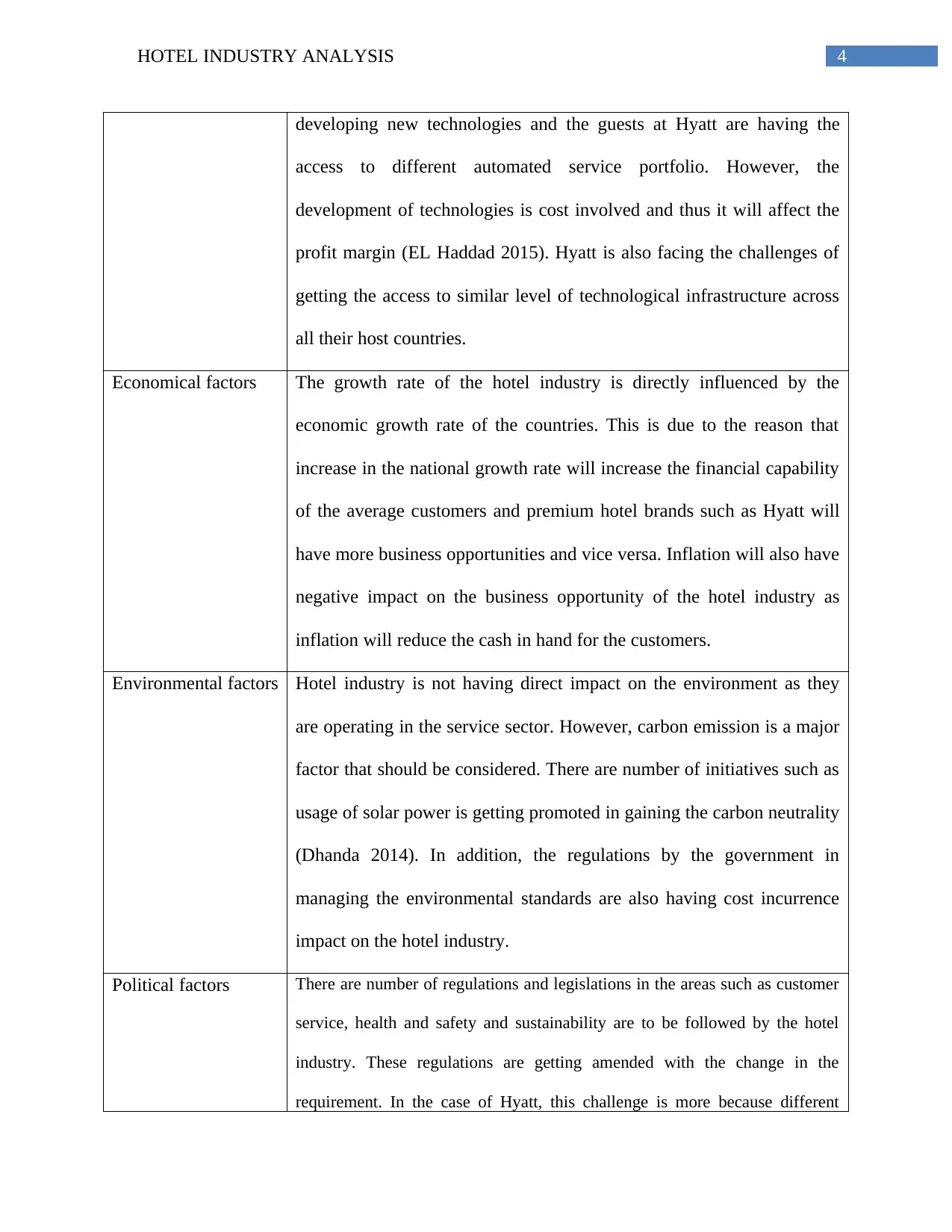
4HOTEL INDUSTRY ANALYSIS
developing new technologies and the guests at Hyatt are having the
access to different automated service portfolio. However, the
development of technologies is cost involved and thus it will affect the
profit margin (EL Haddad 2015). Hyatt is also facing the challenges of
getting the access to similar level of technological infrastructure across
all their host countries.
Economical factors The growth rate of the hotel industry is directly influenced by the
economic growth rate of the countries. This is due to the reason that
increase in the national growth rate will increase the financial capability
of the average customers and premium hotel brands such as Hyatt will
have more business opportunities and vice versa. Inflation will also have
negative impact on the business opportunity of the hotel industry as
inflation will reduce the cash in hand for the customers.
Environmental factors Hotel industry is not having direct impact on the environment as they
are operating in the service sector. However, carbon emission is a major
factor that should be considered. There are number of initiatives such as
usage of solar power is getting promoted in gaining the carbon neutrality
(Dhanda 2014). In addition, the regulations by the government in
managing the environmental standards are also having cost incurrence
impact on the hotel industry.
Political factors There are number of regulations and legislations in the areas such as customer
service, health and safety and sustainability are to be followed by the hotel
industry. These regulations are getting amended with the change in the
requirement. In the case of Hyatt, this challenge is more because different
developing new technologies and the guests at Hyatt are having the
access to different automated service portfolio. However, the
development of technologies is cost involved and thus it will affect the
profit margin (EL Haddad 2015). Hyatt is also facing the challenges of
getting the access to similar level of technological infrastructure across
all their host countries.
Economical factors The growth rate of the hotel industry is directly influenced by the
economic growth rate of the countries. This is due to the reason that
increase in the national growth rate will increase the financial capability
of the average customers and premium hotel brands such as Hyatt will
have more business opportunities and vice versa. Inflation will also have
negative impact on the business opportunity of the hotel industry as
inflation will reduce the cash in hand for the customers.
Environmental factors Hotel industry is not having direct impact on the environment as they
are operating in the service sector. However, carbon emission is a major
factor that should be considered. There are number of initiatives such as
usage of solar power is getting promoted in gaining the carbon neutrality
(Dhanda 2014). In addition, the regulations by the government in
managing the environmental standards are also having cost incurrence
impact on the hotel industry.
Political factors There are number of regulations and legislations in the areas such as customer
service, health and safety and sustainability are to be followed by the hotel
industry. These regulations are getting amended with the change in the
requirement. In the case of Hyatt, this challenge is more because different
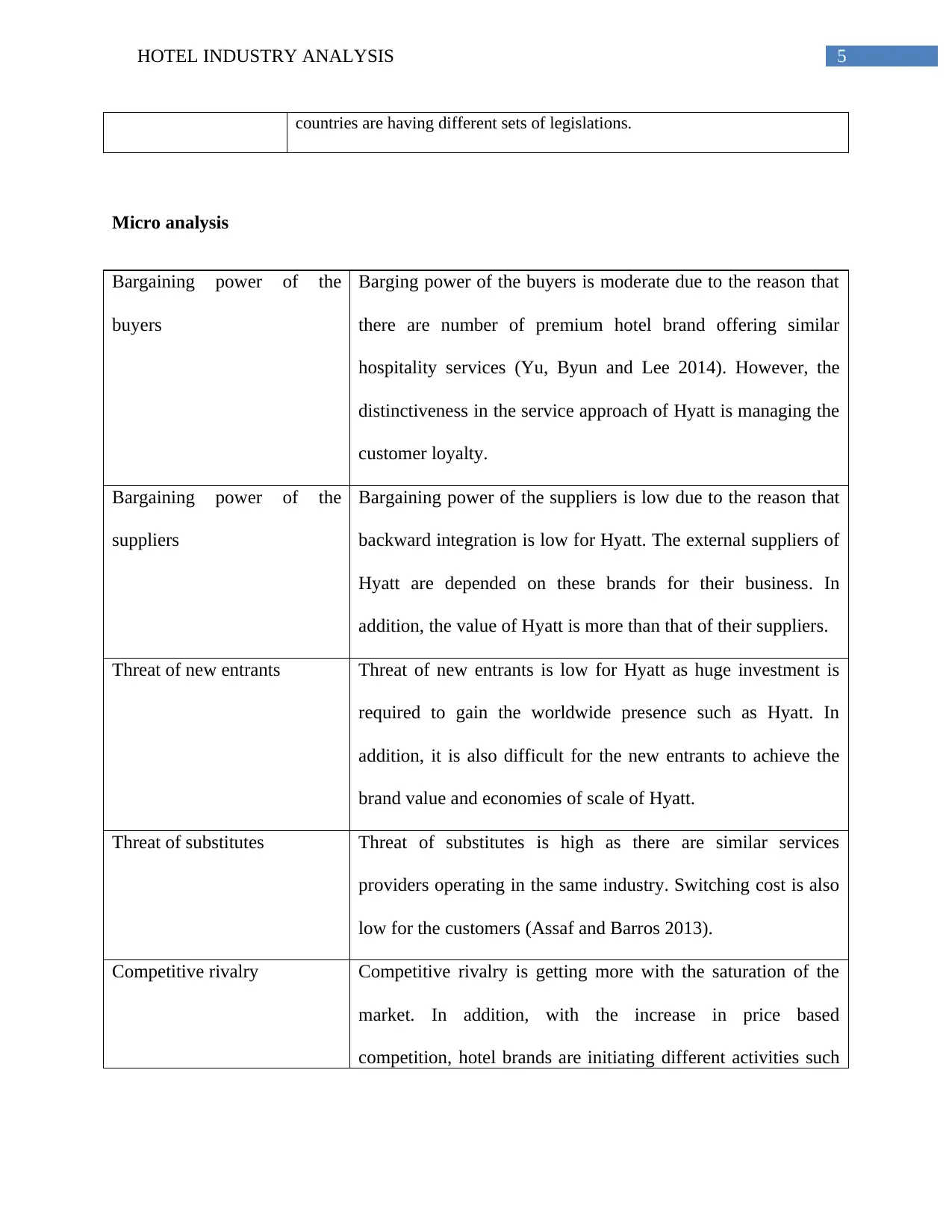
5HOTEL INDUSTRY ANALYSIS
countries are having different sets of legislations.
Micro analysis
Bargaining power of the
buyers
Barging power of the buyers is moderate due to the reason that
there are number of premium hotel brand offering similar
hospitality services (Yu, Byun and Lee 2014). However, the
distinctiveness in the service approach of Hyatt is managing the
customer loyalty.
Bargaining power of the
suppliers
Bargaining power of the suppliers is low due to the reason that
backward integration is low for Hyatt. The external suppliers of
Hyatt are depended on these brands for their business. In
addition, the value of Hyatt is more than that of their suppliers.
Threat of new entrants Threat of new entrants is low for Hyatt as huge investment is
required to gain the worldwide presence such as Hyatt. In
addition, it is also difficult for the new entrants to achieve the
brand value and economies of scale of Hyatt.
Threat of substitutes Threat of substitutes is high as there are similar services
providers operating in the same industry. Switching cost is also
low for the customers (Assaf and Barros 2013).
Competitive rivalry Competitive rivalry is getting more with the saturation of the
market. In addition, with the increase in price based
competition, hotel brands are initiating different activities such
countries are having different sets of legislations.
Micro analysis
Bargaining power of the
buyers
Barging power of the buyers is moderate due to the reason that
there are number of premium hotel brand offering similar
hospitality services (Yu, Byun and Lee 2014). However, the
distinctiveness in the service approach of Hyatt is managing the
customer loyalty.
Bargaining power of the
suppliers
Bargaining power of the suppliers is low due to the reason that
backward integration is low for Hyatt. The external suppliers of
Hyatt are depended on these brands for their business. In
addition, the value of Hyatt is more than that of their suppliers.
Threat of new entrants Threat of new entrants is low for Hyatt as huge investment is
required to gain the worldwide presence such as Hyatt. In
addition, it is also difficult for the new entrants to achieve the
brand value and economies of scale of Hyatt.
Threat of substitutes Threat of substitutes is high as there are similar services
providers operating in the same industry. Switching cost is also
low for the customers (Assaf and Barros 2013).
Competitive rivalry Competitive rivalry is getting more with the saturation of the
market. In addition, with the increase in price based
competition, hotel brands are initiating different activities such
⊘ This is a preview!⊘
Do you want full access?
Subscribe today to unlock all pages.

Trusted by 1+ million students worldwide
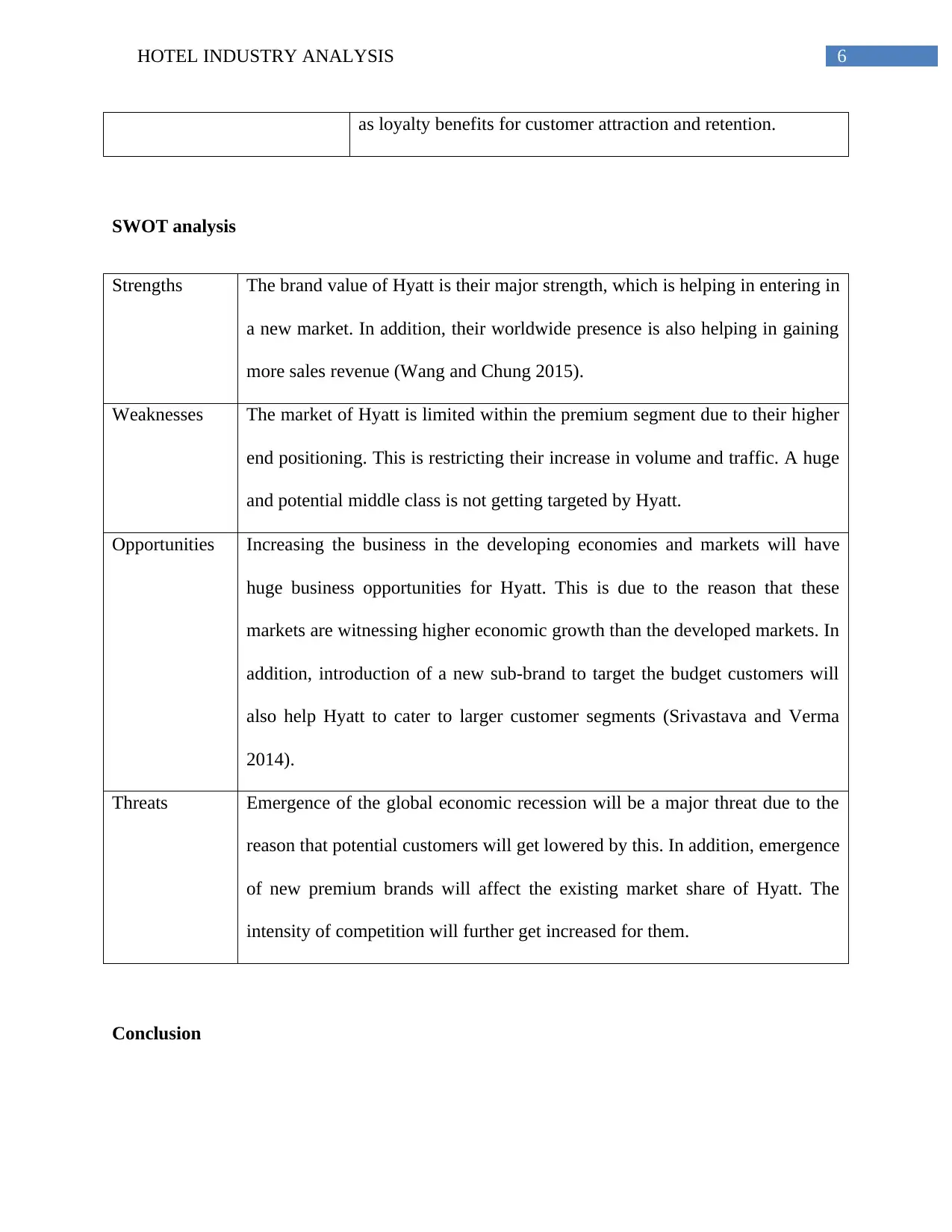
6HOTEL INDUSTRY ANALYSIS
as loyalty benefits for customer attraction and retention.
SWOT analysis
Strengths The brand value of Hyatt is their major strength, which is helping in entering in
a new market. In addition, their worldwide presence is also helping in gaining
more sales revenue (Wang and Chung 2015).
Weaknesses The market of Hyatt is limited within the premium segment due to their higher
end positioning. This is restricting their increase in volume and traffic. A huge
and potential middle class is not getting targeted by Hyatt.
Opportunities Increasing the business in the developing economies and markets will have
huge business opportunities for Hyatt. This is due to the reason that these
markets are witnessing higher economic growth than the developed markets. In
addition, introduction of a new sub-brand to target the budget customers will
also help Hyatt to cater to larger customer segments (Srivastava and Verma
2014).
Threats Emergence of the global economic recession will be a major threat due to the
reason that potential customers will get lowered by this. In addition, emergence
of new premium brands will affect the existing market share of Hyatt. The
intensity of competition will further get increased for them.
Conclusion
as loyalty benefits for customer attraction and retention.
SWOT analysis
Strengths The brand value of Hyatt is their major strength, which is helping in entering in
a new market. In addition, their worldwide presence is also helping in gaining
more sales revenue (Wang and Chung 2015).
Weaknesses The market of Hyatt is limited within the premium segment due to their higher
end positioning. This is restricting their increase in volume and traffic. A huge
and potential middle class is not getting targeted by Hyatt.
Opportunities Increasing the business in the developing economies and markets will have
huge business opportunities for Hyatt. This is due to the reason that these
markets are witnessing higher economic growth than the developed markets. In
addition, introduction of a new sub-brand to target the budget customers will
also help Hyatt to cater to larger customer segments (Srivastava and Verma
2014).
Threats Emergence of the global economic recession will be a major threat due to the
reason that potential customers will get lowered by this. In addition, emergence
of new premium brands will affect the existing market share of Hyatt. The
intensity of competition will further get increased for them.
Conclusion
Paraphrase This Document
Need a fresh take? Get an instant paraphrase of this document with our AI Paraphraser
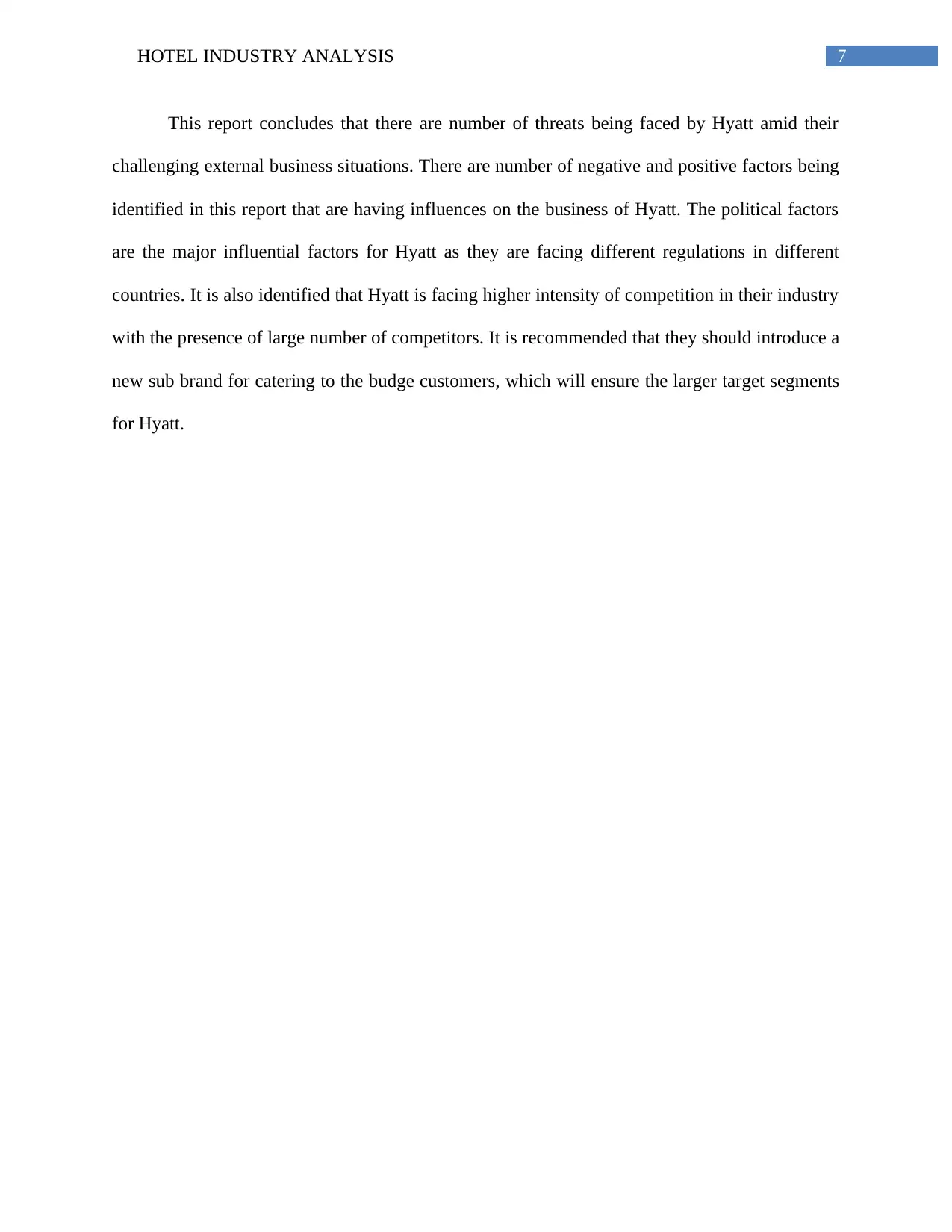
7HOTEL INDUSTRY ANALYSIS
This report concludes that there are number of threats being faced by Hyatt amid their
challenging external business situations. There are number of negative and positive factors being
identified in this report that are having influences on the business of Hyatt. The political factors
are the major influential factors for Hyatt as they are facing different regulations in different
countries. It is also identified that Hyatt is facing higher intensity of competition in their industry
with the presence of large number of competitors. It is recommended that they should introduce a
new sub brand for catering to the budge customers, which will ensure the larger target segments
for Hyatt.
This report concludes that there are number of threats being faced by Hyatt amid their
challenging external business situations. There are number of negative and positive factors being
identified in this report that are having influences on the business of Hyatt. The political factors
are the major influential factors for Hyatt as they are facing different regulations in different
countries. It is also identified that Hyatt is facing higher intensity of competition in their industry
with the presence of large number of competitors. It is recommended that they should introduce a
new sub brand for catering to the budge customers, which will ensure the larger target segments
for Hyatt.
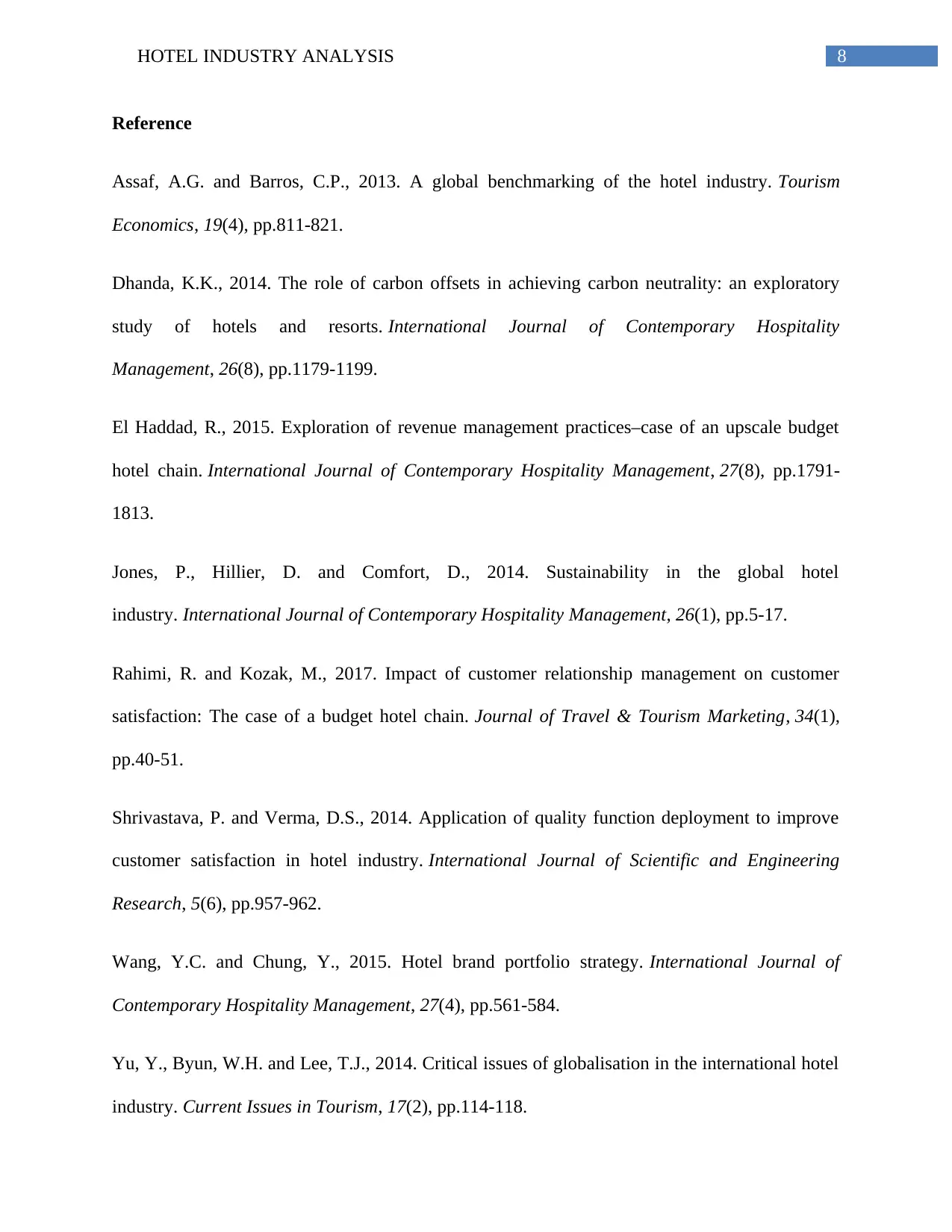
8HOTEL INDUSTRY ANALYSIS
Reference
Assaf, A.G. and Barros, C.P., 2013. A global benchmarking of the hotel industry. Tourism
Economics, 19(4), pp.811-821.
Dhanda, K.K., 2014. The role of carbon offsets in achieving carbon neutrality: an exploratory
study of hotels and resorts. International Journal of Contemporary Hospitality
Management, 26(8), pp.1179-1199.
El Haddad, R., 2015. Exploration of revenue management practices–case of an upscale budget
hotel chain. International Journal of Contemporary Hospitality Management, 27(8), pp.1791-
1813.
Jones, P., Hillier, D. and Comfort, D., 2014. Sustainability in the global hotel
industry. International Journal of Contemporary Hospitality Management, 26(1), pp.5-17.
Rahimi, R. and Kozak, M., 2017. Impact of customer relationship management on customer
satisfaction: The case of a budget hotel chain. Journal of Travel & Tourism Marketing, 34(1),
pp.40-51.
Shrivastava, P. and Verma, D.S., 2014. Application of quality function deployment to improve
customer satisfaction in hotel industry. International Journal of Scientific and Engineering
Research, 5(6), pp.957-962.
Wang, Y.C. and Chung, Y., 2015. Hotel brand portfolio strategy. International Journal of
Contemporary Hospitality Management, 27(4), pp.561-584.
Yu, Y., Byun, W.H. and Lee, T.J., 2014. Critical issues of globalisation in the international hotel
industry. Current Issues in Tourism, 17(2), pp.114-118.
Reference
Assaf, A.G. and Barros, C.P., 2013. A global benchmarking of the hotel industry. Tourism
Economics, 19(4), pp.811-821.
Dhanda, K.K., 2014. The role of carbon offsets in achieving carbon neutrality: an exploratory
study of hotels and resorts. International Journal of Contemporary Hospitality
Management, 26(8), pp.1179-1199.
El Haddad, R., 2015. Exploration of revenue management practices–case of an upscale budget
hotel chain. International Journal of Contemporary Hospitality Management, 27(8), pp.1791-
1813.
Jones, P., Hillier, D. and Comfort, D., 2014. Sustainability in the global hotel
industry. International Journal of Contemporary Hospitality Management, 26(1), pp.5-17.
Rahimi, R. and Kozak, M., 2017. Impact of customer relationship management on customer
satisfaction: The case of a budget hotel chain. Journal of Travel & Tourism Marketing, 34(1),
pp.40-51.
Shrivastava, P. and Verma, D.S., 2014. Application of quality function deployment to improve
customer satisfaction in hotel industry. International Journal of Scientific and Engineering
Research, 5(6), pp.957-962.
Wang, Y.C. and Chung, Y., 2015. Hotel brand portfolio strategy. International Journal of
Contemporary Hospitality Management, 27(4), pp.561-584.
Yu, Y., Byun, W.H. and Lee, T.J., 2014. Critical issues of globalisation in the international hotel
industry. Current Issues in Tourism, 17(2), pp.114-118.
⊘ This is a preview!⊘
Do you want full access?
Subscribe today to unlock all pages.

Trusted by 1+ million students worldwide
1 out of 9
Related Documents
Your All-in-One AI-Powered Toolkit for Academic Success.
+13062052269
info@desklib.com
Available 24*7 on WhatsApp / Email
![[object Object]](/_next/static/media/star-bottom.7253800d.svg)
Unlock your academic potential
Copyright © 2020–2025 A2Z Services. All Rights Reserved. Developed and managed by ZUCOL.





